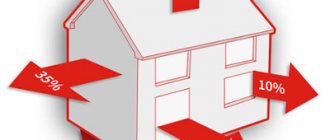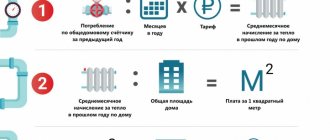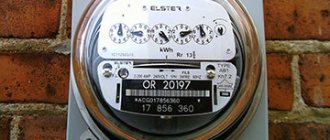How is the payment for heating in an apartment calculated? It is unlikely that most residents of apartments in high-rise buildings or owners of houses and non-residential premises connected to a centralized heating system will be able to answer this question quickly and clearly. And the problem is not that people are not interested in this issue or they “don’t understand the task”, the problem is that a very interesting situation has developed in the heat supply market, which is characterized by a very complex and cumbersome system for setting tariffs and, as a result, payments for consumers.
Considering the fact that accounting for thermal energy is associated with certain difficulties, cumbersome formulas are used for calculations, which are not always easy for even specialists to understand. But recently, there has been a tendency that consumers have become interested in this issue and are trying to figure out on their own how to calculate how much to pay for heating in an apartment or house. And this is due to the fact that the amounts in payments for consumed gigacalories are constantly growing, which significantly affects the financial situation of users who have realized the fact that they are quite capable of influencing this process themselves, and in addition, there are quite working legislative norms, significantly simplifying the task and protecting the consumer.
ORDER A SERVICE FROM ACCREDITED COMPANIES
Who should pay for heating: the owner or the registered
Before you figure out how to pay for heating, you should find out who is responsible for this and should deal with this issue. But you should immediately understand that the owner of the premises is primarily responsible for timely payment, regardless of the fact of registration and residence. And then the nuances begin, of which there are quite a lot, and they can be very confusing, so much so that citizens even have to turn to the courts both for clarification and in order to defend their rights.
Consumers should also be aware that registration at a specific address not only gives them the right to live in the premises and use utilities, but also makes them responsible for paying for them. But even in this case there are exceptions. For example, if a person is registered, but temporarily lives at a different address and this fact has documentary evidence, then he may be exempt from paying for those resources, which are accounted for using individual measuring instruments. Accordingly, you will still have to pay for heat, since in many apartment buildings, due to the presence of horizontal pipe distribution, only common house metering devices are installed. But if there are counters, then the problem is solved using a general algorithm. At the same time, there is even the possibility of accruals for an incomplete month, but if the period of absence is 5 or more days.
A very common problem remains the situation in which family members become former, but at the same time retain their registration at the old place of residence. This point applies to both spouses after divorce and grown children who have moved to another permanent place of residence. In this case, the fact of registration does not lead to the automatic imposition of obligations to pay for utilities, including heating, but only if residence in another place is documented.
It should be recognized that there are a lot of questions about who should pay for heating and in what amount, and it is virtually impossible to consider everything, but as a guide, you can take into account the fact that they are always required to pay for such services:
- owners;
- employers;
- developers or shareholders (in new houses);
- members of various cooperatives and associations (in this case, most often we mean non-residential premises, including heated garages and parking lots);
- family members;
- former family members, if they retained the right to use the premises.
In this case, the owner, even in the absence of registration, is still responsible for timely payment for the heating services received.
Selection of heating radiators
Traditionally, it is recommended to select the power of a heating radiator according to the area of the heated room, with a 15-20% overestimation of power requirements, just in case.
Using an example, let’s look at how correct the methodology for choosing a radiator is “10 m2 area - 1.2 kW”.
The thermal power of radiators depends on the method of their connection, which must be taken into account when calculating the heating system
Initial data: corner room on the first level of a two-story individual housing construction building; external wall made of double-row ceramic bricks; room width 3 m, length 4 m, ceiling height 3 m.
Using a simplified selection scheme, it is proposed to calculate the area of the room, we consider:
3 (width) 4 (length) = 12 m2
Those. the required power of the heating radiator with a 20% increase is 14.4 kW. Now let’s calculate the power parameters of the heating radiator based on the heat loss of the room.
In fact, the area of the room affects the loss of thermal energy less than the area of its walls, facing one side outside the building (facade).
Therefore, we will calculate exactly the area of the “street” walls present in the room:
3 (width) 3 (height) + 4 (length) 3 (height) = 21 m2
Knowing the area of the walls that transfer heat “to the street,” we will calculate the heat loss for a difference in room and street temperatures of 30° (in the house +18°C, outside -12°C), and immediately in kilowatt-hours:
0.91 21 30: 1000 = 0.57 kW,
Where: 0.91 - heat transfer resistance m2 of room walls facing “outside”; 21 - area of “street” walls; 30 - temperature difference inside and outside the house; 1000 is the number of watts in a kilowatt.
According to building standards, heating devices are located in areas of maximum heat loss. For example, radiators are installed under window openings, heat guns are installed above the entrance to the house. In corner rooms, batteries are installed on blank walls exposed to maximum exposure to winds.
It turns out that to compensate for heat loss through the facade walls of this structure, with a 30° temperature difference in the house and outside, heating with a capacity of 0.57 kWh is sufficient. Let's increase the required power by 20, even 30% - we get 0.74 kWh.
Thus, real heating power requirements may be significantly lower than the trading scheme “1.2 kW per square meter of room area.”
Moreover, correct calculation of the required power of heating radiators will reduce the volume of coolant in the heating system, which will reduce the load on the boiler and fuel costs.
What is the most profitable way to pay for heating: by meter or standard
There are several ways to calculate the payment for heating in an apartment, but two can be considered the main ones:
- according to the standard;
- according to the readings of metering devices: communal or communal and individual.
At the same time, it is not easy for a consumer to determine the most optimal payment option for himself, especially since he does not always have a real opportunity to influence the selection process itself. This is due both to the complexity of heat energy accounting and to existing obstacles caused by service providers. In addition, despite the fact that the legislative framework in this area is being actively developed taking into account the interests of the consumer, there are still a lot of loopholes for utility services and organizations that supply thermal energy to manipulate this issue and, naturally, not in favor of the recipient of the service.
Therefore, sometimes, contrary to popular belief, in order to save on payments, you do not need to install heat meters; payment according to the standard may be a more profitable option. Although, there are situations when this is not the case. The most common of these situations can be considered one in which the consumer has the technical ability to install an individual measuring instrument, but for some reason he refuses to install a meter - in this case, as a rule, charges are also made according to the standard, but with an increasing coefficient, and this is no longer profitable.
Next, the most common methods of calculating payments for heat will be considered, but you should always know that it is often impossible for residents living in apartment buildings to influence the formulas used by public utilities, much less the tariffs. They cannot always choose the payment method on their own, even after they have installed an IPU in their apartment. At the same time, taking energy saving measures also does not always help achieve the desired result, although the apartments definitely become more comfortable after this.
How to calculate heating fees without a meter
It will not be possible to honestly and at the same time correctly calculate the payment for heating in an apartment building, and since this function is the prerogative of utility services or service providers, it is not difficult to guess which option will prevail. In addition, the objective reality is that the price of various types of resources used for heat production is steadily increasing and there is no tendency in the opposite direction. Therefore, the increase in amounts in payments will be constant and very noticeable. This is precisely why consumers want to install meters, but in many cases this is an almost impossible task.
Despite the fact that according to the law, all consumers of services must take care of installing metering devices, this requirement is not always technically feasible. And if for rental properties such a requirement has been a mandatory norm since 2012, then for houses of earlier construction it is an almost impossible task. And this problem is especially relevant for the heat supply sector.
Firstly, the installation of individual meters, although technically possible, is not economically justified, especially since even the owner of a one-room apartment will need at least two devices. This is due to the peculiarities of vertical wiring, which is prevalent in most houses in Russian cities;
Secondly, the problem seems to be perfectly solved by installing a common house heat meter. But even in this case, not everything is so easy, since this, as a rule, requires the consent of all apartment owners. And in this case, it often turns out like Ivan Krylov - this is about when there is no agreement among comrades.
Therefore, how much residents of houses without metering devices pay for heating per month is determined by the formula O=P ×H ×T , in which:
“O” is the amount of charges for the heat received;
“P” – area of the room;
“N” is the heat rate required to heat 1 m2 and is defined as Gcal/m2. But since this value depends on the climatic characteristics of the region and weather conditions, this value is variable and varies in different cities;
“T” is the price of 1 Gcal of heat used in the tariff.
How to pay for heating using a meter in an apartment
How to pay for heat using an individual meter? On the one hand, it’s easy to answer this question: I took the consumption readings, multiplied them by the price of Gcal and that’s it. But on the other hand, everything is not so simple, although in many cases this charging option is the most optimal for the consumer, it also has a lot of pitfalls.
To start paying for heat using a meter, you will need to install it, and for this you need to obtain special permission from the service provider, which is sometimes a difficult task. Although for those who live in houses put into operation after 2012, this problem does not exist, since all residential properties are rented out only after all types of individual metering devices have been installed, including means of measuring coolant flow.
In the event that there is a meter, charges are made solely according to instrument readings. And this approach would seem to be beneficial, especially if the consumer additionally uses weather-dependent equipment or has the ability to regulate the amount of coolant flow. However, if you use heat wastefully, then no meter will save you, and in this case there may even be a noticeable increase in charges on your bills. Therefore, it is profitable to pay by meter if you use the heat resource rationally, but only if the apartment is “warm”, that is, has effective thermal insulation. Under other conditions, the consumer will be forced to solve a dilemma: pay more or continue to freeze.
In addition, until 2015 there was a rule (which, to the surprise and displeasure of consumers, is still used in some cases), the essence of which was that if in at least one of the premises the heat meter failed or its data was declared invalid, then all other consumers of the apartment building must be transferred to payment according to the standard. Court decisions and various clarifications have made it possible to remove such a discriminatory rule, but exceptions do occur.
Calculation of heating boiler power
The boiler as part of the heating system is designed to compensate for the heat loss of the building. And also, in the case of a double-circuit system or when equipping the boiler with an indirect heating boiler, to warm water for hygienic needs.
By calculating the daily heat loss and the consumption of warm water “to the sewer”, you can accurately determine the required boiler power for a cottage of a certain area and the characteristics of the enclosing structures.
A single-circuit boiler only heats the coolant for the heating system
To determine the power of the heating boiler, it is necessary to calculate the cost of thermal energy of the house through the facade walls and for heating the changing air atmosphere of the interior.
Data on heat loss in kilowatt-hours per day is required - in the case of a conventional house, calculated as an example, this is:
271.512 + 45.76 = 317.272 kWh,
Where: 271.512 - daily heat loss from external walls; 45.76 - daily heat loss for heating the supply air.
Accordingly, the required heating power of the boiler will be:
317.272: 24 (hours) = 13.22 kW
However, such a boiler will be under a constantly high load, reducing its service life. And on especially frosty days, the design power of the boiler will not be enough, since with a high temperature difference between the room and street atmospheres, the heat loss of the building will sharply increase.
Therefore, you should not choose a boiler based on an average calculation of thermal energy costs - it may not cope with severe frosts.
It would be rational to increase the required power of boiler equipment by 20%:
13.22 · 0.2 + 13.22 = 15.86 kW
To calculate the required power of the second circuit of the boiler that heats water for washing dishes, bathing, etc., you need to divide the monthly heat consumption of “sewer” heat losses by the number of days in the month and by 24 hours:
493.82:30:24 = 0.68 kW
Based on the calculations, the optimal boiler power for the example cottage is 15.86 kW for the heating circuit and 0.68 kW for the heating circuit.
General formula for calculations for heat in the presence of apartment meters
And one more aspect: when installing and operating individual heat meters, in any case you have to pay for the maintenance of common areas: corridors, interfloor stairwells, entrances, attics, etc., but in this case, expenses for general house needs are a separate item and in receipts are charged separately, which allows the consumer to control them. But this does not always happen, and the most common and often used formula for calculations by utilities or service providers is:
O=(P+Ronp ×P/Po) ×T
In this case:
“O” – total charges for heat;
“P” – consumption according to an individual meter;
“P” – area of the room or apartment;
“By” – the total area of all premises in the house, including residential and non-residential;
“Ronp” – heat consumption for non-residential public premises;
“T” is the tariff used for charges and expressed as the cost of 1 Gcal of heat.
In addition, if there is a common house meter, its readings must be taken into account, which are also entered into the calculation formula. In this case, readings on the common house meter must be taken and the data from all individual devices are summarily subtracted from them, and then the calculation is made in a similar way.
It is important to consider that before you switch to paying for heat using individual meters, you need to buy these devices. And the easiest way to do this is in the RosSchet online store, which offers a wide range of these devices from different manufacturers. Therefore, it will be easy for the consumer to choose a measuring instrument taking into account the technical features of the heating system, as well as the cost of the meter. And if qualified assistance is required, the buyer can always count on receiving professional advice.
How are heating charges calculated if there is a communal meter?
If it is not possible to install an individual meter, then building-wide heat meters can significantly reduce heating fees. Although many do not consider this method of accounting to be completely fair, for the majority of consumers in our country it is the most accessible and quite workable, since it allows users to directly control costs and, in some cases, strive to optimize them, including through thermal insulation of rooms in the house.
But regardless of how energy efficient a house is, payment for heat for consumers with a common house meter installed consists of two types:
- payment for heat in the apartment;
- expenses for heating office premises and common areas.
In this case, it does not matter who charges for heating: a management company, a resource supply company or another service provider organization, the principle is the same and the main feature of such calculations can be considered the use of a proportional approach. First, readings of heat consumption in the house are taken, then the shares used for heating residential and non-residential premises are allocated, and the last stage can be considered charges for each consumer, proportional to the area they occupy in the house. Therefore, if there is a common building heat meter, there is no question of who should pay for heating in the entrance of an apartment building, since the answer is obvious - all residents, but in a fractional proportion of the area of their apartments .
The general formula that is used for calculations in apartment buildings with a common meter can be presented as follows:
O=P ×P/Po ×T , where
“O” – charges for heat;
“P” – consumption according to the common house meter;
“P” – apartment area;
“By” – the total area of all premises in the house, including residential and non-residential;
“T” – the cost of 1 Gcal of heat, in accordance with the approved tariff.
It is important to take into account that determining how many Gcal per 1 m2 when calculating heating payments should be included in the calculations, as a rule, depends on the readings for the same period last year. This principle of calculation is used in many houses equipped with communal meters. But since the expenses for each year do not coincide (weather conditions affect them), recalculations are expected at the end of the heating season. However, sometimes this is not beneficial for suppliers: they can “forget” about it, so service consumers are often forced to look for the “truth” and prove the need for this action. If there is an agreement with a management company or service provider, then all these issues are resolved more easily, but only if such cases and situations are specified in this document.
Laws on heat meters
List of regulations governing payment for heating by meter in an apartment building from 2022:
- The Housing Code of the Russian Federation, which sets out the initial provisions for the maintenance and payment of housing and communal services.
- Federal Law No. 190-FZ dated July 27, 2010, regulating the procedure for the production and transfer of heat, as well as all other relations arising in this area.
- Rules..., approved. RF PP dated 05/06/2011 No. 354 with amendments that came into force in 2022. They detail the procedure for calculating payments for heat, the quality of the supplied energy resource, as well as the procedure for installing heating meters.
- RF PP dated July 29, 2013 No. 642, which contains the rules for hot water supply.
- RF PP dated July 29, 2013 No. 644, which contains the Rules for cold water supply and sanitation.
- RF PP dated November 18, 2013 No. 1034, which contains the basic requirements for heat metering units.
- Other acts in the field of water supply, as well as GOSTs and SNiPs.
How to pay for heating through Sberbank online
The easiest way to pay utility bills, including heating services, is through Sberbank Online - for this, the service provides several options, which allows consumers to choose the best method for them.
The most common method is to make a payment through your personal account - to do this you need to log in and, using informative prompts, make a payment. As a rule, when creating a personal account, all details are filled out and saved, which greatly simplifies the task for the payer of services, since there is no need to enter personal account details, TIN or other information each time. Just find the supplier’s tab and click on it, and then the system will do everything itself, even generate a receipt, which, if necessary, can be easily printed. If the accounts are linked to the Sberbank Online system, there is no need to even enter data, they will already be displayed, all that remains is to confirm the action.
Also, in order not to manually enter data and details, you can use a QR code or barcode - for this you need to scan them.
The procedure in this case is quite simple and looks like this:
- first you need to go to the banking application or personal account;
- then click on the “Payments” icon (as an option – “Payments and transfers”);
- after that, select the “My Operations” section;
- then, in the window that opens, enter the data, including scanning it from the receipt;
- make the payment and complete the transaction.
In the event that it is impossible to scan the code, in order to pay you need to enter the recipient’s data using one of the following types of details:
- checking account;
- Name;
- TIN.
If the organization is not displayed in this way, then you can pay for heat supply services by entering all the recipient’s details that are indicated in the receipt.
Autopayment can be considered a very convenient payment method; in this case, the consumer of heat services delegates his powers to the bank, which carries out the financial transaction according to a predetermined schedule. However, the user can change these conditions or make adjustments to them at any time.
You can also activate this service by logging into the Sberbank Online application. Next, you should select: the section “Payments”, “Autopayments”, then strictly follow the prompts.
The message about the next payment should arrive in the form of SMS a day before, so the user has the opportunity to cancel or postpone it, otherwise the payment will be sent, and the bank client will receive a notification about this.
Sberbank Online also allows you to always receive new accounts on time; messages in the form of SMS or push notifications will remind you of this.
In addition, Sberbank leaves room for more traditional methods of paying for heat: through terminals or directly at bank branches.
Calculation for a communal apartment
Heating in a regular type apartment and a communal one is calculated approximately the same way. The latter case is characterized only by a proportional distribution of payment for each room.
For this type of room, the calculation can be carried out using the following expression:
Pj.i=((Vi×Sj.i)/Ski)×TT,
Where:
- i – area of a single room;
- Ski – common squares located in a communal apartment.
Heating of non-residential areas is almost minimal, so this formula is not taken into account.
Where is heat lost and what types of heat meters are there?
In what cases can you not pay for heating in an apartment?
Unlike other types of resources: water, light or gas, received by the owners of apartments, houses or, for example, a store located in a non-residential building of a high-rise building, heat supply refers to the so-called general service, and refuse to receive it and, especially, to pay, in in most cases, almost impossible. Some consumers, dissatisfied with the quality of the supplied coolant and by hook or by crook, have received permission to install individual boilers in apartments, are still required to pay for heat supply services received from the central pipeline, although this norm has been officially abolished since 2015. Sometimes they manage to prove their right to such re-equipment of their premises and pay only for heating of common areas. But such cases are very rare, so most often you have to bear the financial burden twice as much.
You also cannot refuse to pay for heat if, for example, no one lives in the apartment for some time (the family went to a resort, on a business trip, etc.). Based on the fact that the service is general, regardless of the fact of residence during a specific period, the service is still provided and, accordingly, it should be paid for.
But there are still situations in which it is possible not to pay for heating services for a certain period of time, but it should be noted that the path of proving one’s case is very difficult and long, and sometimes ends in vain.
There are rules defining situations in which a consumer can refuse to pay for heat, and all of them are contained in Resolution No. 354, adopted by the Government of Russia on May 6, 2011 (as amended on July 31, 2021) “On the provision of utility services to owners and users of premises in apartment buildings and residential buildings." And in accordance with this document, the most common situations in the event of which you can exercise the right not to pay for the heat received can be considered the following:
- untimely start or completion of the heat supply season - in this case, consumers have the right to demand a recalculation downward in proportion to the days of such delay. But this option is relevant only for objects without metering devices, and also if there is only a common building meter;
- provision of poor-quality service - several situations fit this concept: failure to comply with the required temperature conditions in the room, neglect of the rules for lowering the temperature of the coolant, as well as interruptions in the supply of heat, in total exceeding 24 hours a month or one-time, but for 16 hours;
- failure to comply with pressure standards in the system, which are equal to 0.6 MPa or 0.1 MPa if cast iron and, accordingly, other types of radiators are installed.
In addition to these most common cases, there are others, for example, sometimes owners may not pay for heating in a dilapidated house, but such “luck” does not always happen and not for everyone. But regardless of the reason for receiving low-quality heating services, in order to achieve a recalculation, or legally refuse payment, it is necessary to document all such situations and submit appropriate applications to the service provider to draw up an act. Therefore, given the tediousness and complexity of completing this quest, many consumers prefer not to get involved in such matters and let everything take its course to the delight of managers and other utility companies.
Do I need to pay for heating in the summer?
Why do we pay for heating in the summer? This question is often asked by consumers during the warm season, when they receive bills with charges for utility services. However, in winter this version of the question, as a rule, does not arise. In order to understand this, you first need to know that there are two ways to generate charges: throughout the year (despite the fact that the receipt of the service is limited to several months) and exclusively during the heating season. Therefore, how much and why we pay for heating all year round depends on this factor, and in what cases it occurs, we should understand in more detail.
If payments for heat are made only during the heating season, which in most regions of Russia lasts 7 months, then during this period, charges, as a rule, greatly increase consumer costs. With a 12-month payment system, this imbalance is removed due to an even distribution over the summer months. As a rule, in houses with communal meters, the initial data is the readings of the previous year, and subsequently, at the end of the current season, a recalculation is made.
If payment is made according to the standard, then a conditional value is accepted for calculations, which, however, is also calculated on the basis of consumption readings for past periods. At the same time, recalculations, although possible, are rarely used. Therefore, the question should not be about why we pay for heat all year round, but how to optimize our costs for paying for it. And in what shares to pay for heat is no longer so important.
Often, without the help of specialists, it is not possible to understand the issues of charges and data transfer for the heat received. Therefore, if you need advice, you can always get it on the RosChet website. And if you need to buy metering devices and install them, then our online store of the same name is always at your service.
The IPU is out of order and lost: three months have passed.
According to Part 7 of Art. 13 of the Federal Law of November 23, 2009 No. 261 Federal Law “On energy saving and on increasing energy efficiency and on introducing amendments to certain legislative acts of the Russian Federation” MKDs put into operation from 01/01/2012 after construction, reconstruction, must be equipped with an additional IPU of the heat used energy, and in houses put into operation from the specified date after major repairs, IPU for used thermal energy must be installed if it is technically possible to install them. Owners of metering devices for used energy resources are obliged to ensure proper operation of these meters, their safety and timely replacement.
Paragraph 81 of the Rules for the Provision of Public Utilities also states that the equipping of residential or non-residential premises with metering devices, the commissioning of installed meters, their proper technical operation, safety and timely replacement must be ensured by the owner of the residential or non-residential premises.
How to calculate the consumed thermal energy?
If for one reason or another there is no heat meter, then to calculate thermal energy you must use the following formula:
Vx(T1-T2)/1000=Q
Let's look at what these symbols mean.
1. V denotes the amount of hot water consumed, which can be calculated either in cubic meters or in tons.
2. T1 is the temperature indicator of the hottest water (traditionally measured in the usual degrees Celsius). In this case, it is preferable to use exactly the temperature that is observed at a certain operating pressure. By the way, the indicator even has a special name - enthalpy. But if the required sensor is missing, then as a basis you can take the temperature regime that is extremely close to this enthalpy. In most cases, the average is approximately 60-65 degrees.
3. T2 in the above formula also denotes the temperature, but of cold water. Due to the fact that it is quite difficult to penetrate the main line with cold water, constant values are used as this value, which can change depending on the climatic conditions outside. So, in winter, when the heating season is in full swing, this figure is 5 degrees, and in the summer, when the heating is turned off, 15 degrees.
4. As for 1000, this is the standard coefficient used in the formula in order to obtain the result in gigacalories. It will be more accurate than if you used calories.
5. Finally, Q is the total amount of thermal energy.
As you can see, there is nothing complicated here, so we move on. If the heating circuit is of a closed type (and this is more convenient from an operational point of view), then the calculations must be made slightly differently. The formula that should be used for a building with a closed heating system should look like this:
((V1x(T1-T)-(V2x(T2-T))=Q
Now, accordingly, to the decoding.
1. V1 indicates the flow rate of the working fluid in the supply pipeline (typically, not only water, but also steam can act as a source of thermal energy).
2. V2 is the flow rate of the working fluid in the return pipeline.
3. T is an indicator of the temperature of a cold liquid.
4. T1 – water temperature in the supply pipeline.
5. T2 – temperature indicator that is observed at the outlet.
6. And finally, Q is the same amount of thermal energy.
It is also worth noting that the calculation of Gcal for heating in this case depends on several notations:
- thermal energy that entered the system (measured in calories);
- temperature indicator during the removal of working fluid through the return pipeline.











